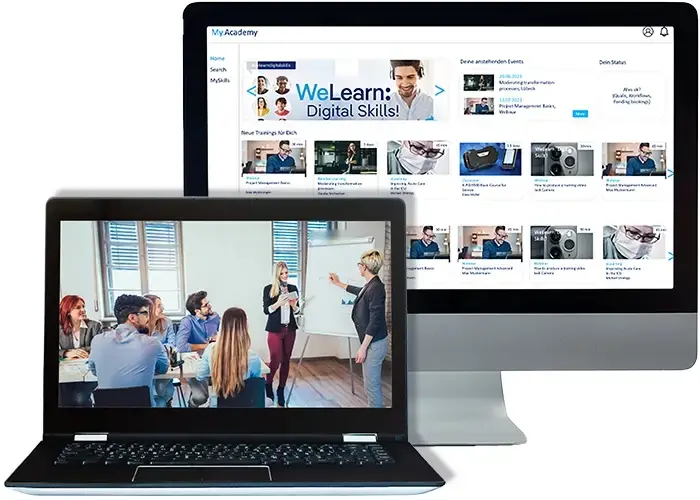Knowledge or Competency: Crafting Meaningful Online Quizzes
Knowledge Tests or Competency Assessments: Creating Real Value in Evaluations

Meaningful online tests are crucial for accurately assessing learning progress and competencies. This text provides valuable insights into the differences between knowledge and competency tests and shows how you can create effective assessments that go beyond simple knowledge checks.
Learn how to develop realistic scenarios, formulate clear learning objectives, and apply transparent assessment methods. With these strategies, you can ensure that your tests not only measure knowledge but also reflect the actual skills of learners in practice.
Benefit from TCmanager®, the professional LMS to create competency-focused assessments that optimally prepare your learners for their professional challenges.
1. The Difference Between Knowledge and Competency Tests
Effective test design begins with the question of what exactly should be measured: knowledge or competency. This distinction is fundamental to creating a meaningful test.
1. Knowledge Tests
A knowledge test shows whether learners can understand and recall predefined content. The questions in knowledge tests are usually aimed at directly providing answers based on learning materials or memorized information.
These tests are particularly useful in the early stages of a learning process to ensure that learners grasp the essential terms, concepts, and foundations.

Examples of Knowledge Tests:
-
- Multiple-choice questions on facts or terms (e.g., “What is the definition of...?”)
- Fill-in-the-blank questions that close knowledge gaps, e.g., “The capital of Italy is...”
- Matching tasks where learners connect terms or definitions.
While these tests provide insight into what learners have memorized, they reveal little about whether they can apply this knowledge or transfer it to different contexts.
2. Competency Tests
Competency tests go beyond mere knowledge assessment and examine how deep the understanding of a topic is and whether learners can apply their knowledge in new contexts, analyze, and interpret information.
They are particularly suitable in advanced learning phases or for complex topics that require problem-solving skills and critical thinking.
Competency tests often include open-ended, scenario-based questions that challenge learners to connect their knowledge and apply it practically.
Examples of Competency Tests:
-
- Scenario questions that require learners to analyze a situation and develop a solution (e.g., “How would you proceed in situation XY?”)
- Tasks where learners must make decisions or design processes (e.g., “Plan the following steps to implement a marketing strategy.”)
- Simulations and interactive exercises where learners apply practical skills or problem-solving approaches.
2. Defining Learning Objectives: What Should the Test Really Measure?
Before starting to create a test, a precise definition of the learning objectives is crucial. Learning objectives are the foundation for determining which competencies or knowledge learners should develop and how these can be assessed. A clear understanding of the learning objectives helps you create appropriate questions that measure not only knowledge but also the desired application and problem-solving competencies.

Formulation of Knowledge Objectives
Knowledge objectives define what learners should know or understand. These objectives include fundamental information, definitions, and concepts important to the topic. A knowledge test is useful when learners should internalize specific information, definitions, or steps that are necessary as a foundation for more complex skills. Knowledge objectives are particularly useful:
- In early learning phases: Knowledge tests help ensure that learners master the foundational information before tackling more complex content.
- For examinations and certifications: In some fields, such as legal or safety-related topics, understanding and recalling specific information is sufficient and necessary to verify that learners have internalized the required details.
- In defined application cases: Knowledge tests are well-suited when specific content needs to be assessed, e.g., verifying whether safety protocols, definitions, or standard processes are known.
Examples of Knowledge Objectives:
-
- “Learners should be able to name the main phases of a project lifecycle.”
- “Learners know the five most common threats in networks and can define them correctly.”

Formulation of Competency Objectives
Competency objectives go a step further than knowledge objectives and aim for learners to apply what they have learned in various contexts. Instead of memorizing facts, the focus is on applying knowledge in practical situations, solving problems, and executing tasks. Competency objectives ensure that learners not only know the theoretical foundations but also develop the necessary skills for real-world applications.
Examples of Competency Objectives:
- “Learners can examine a network for security vulnerabilities and create a priority list for remediation.”
- “Learners are able to create and apply a technical guide for the installation of an IT system.”
Using Bloom's Taxonomy
Bloom's Taxonomy provides a helpful framework for categorizing learning objectives by difficulty level, from knowledge (recalling facts) to evaluation (critique or judgment). Use this structure to systematically categorize the desired competencies into different levels of difficulty and define both knowledge and competency objectives in a structured manner. (-> find out more about learning concepts)
3. Develop Realistic Scenarios
Tests based on realistic scenarios create a bridge between theory and practice. Such scenarios reflect typical work situations and provide learners with the opportunity to try out their skills in practical contexts. Scenarios not only increase motivation but also promote a deeper understanding of the topic and demonstrate whether learners can transfer knowledge to real challenges.
How to Create Scenarios:
- Incorporate case studies and situations from professional practice: Use tasks that simulate real problems and requirements in practice.
- Build scenarios step-by-step: Provide a brief situational description and allow learners to make decisions in several steps to test their problem-solving skills and decision-making abilities.
Practical Example:
In a course on project management, you could develop a scenario in which learners plan a budget for a new product. In the test, they would receive a detailed description of the project, including objectives, resources, and potential challenges. Questions like “What costs need to be planned, and how do you prioritize expenses if the budget is tight?” provide insights into the learners' ability to think structured and prioritize.
Such scenarios test both knowledge about budget planning and practical skills in problem-solving and resource allocation.

4. Assess Competencies Instead of Knowledge
Competency-oriented tests go beyond mere knowledge assessments and examine how learners can apply, analyze, and use knowledge in unfamiliar contexts. To accurately represent the competencies of learners, you should develop questions that focus on understanding processes and the ability to solve problems.

Designing Competency-Oriented Questions:
- Ask Application Questions: Formulate questions that require learners to apply knowledge in new contexts.
- Encourage Analysis and Interpretation: Ask questions about the “why” and “how” of an answer to assess deeper understanding and interpretation of what has been learned.
- Develop Problem-Oriented Questions: Create tasks that require a solution or decision. Open-ended, interpretive questions compel learners to use their knowledge and think creatively.
Practical Example:
In a course on personnel management, you might pose a question like: “Imagine that a team member is consistently underperforming and showing signs of demotivation. How would you address the problem, and what steps would you take to restore motivation?”
This question tests whether learners understand the principles of employee management and can apply them in a real scenario.
5. Assessment Methods for Open Questions and Competency Tests
Evaluating knowledge tests is generally straightforward and often conducted through automated systems. However, this is more complex for open-ended questions and competency tests. A systematic and transparent evaluation is essential to avoid misinterpretations and to assess learners fairly.

Assessment Methods:
- Use Rating Scales: Create detailed evaluation criteria that establish clear standards for assessing answers. Scales can range from “insufficient” to “excellent” and define specific criteria for each rating.
- Use Rubrics for Complex Answers: Develop rubrics that assess different dimensions of an answer, such as understanding, application, creativity, and problem-solving skills. This creates transparency for learners and facilitates comparability of results.
- Integrate Peer Review Systems: Incorporate peer review, where learners evaluate each other's work. This not only promotes critical thinking but also enhances the ability to give and receive feedback.
Example:
In a course on technical problem-solving, learners could be asked to diagnose and solve a fault in a system. The assessment could be based on a scale of 1 to 5, with criteria covering problem identification, quality of the proposed solution, applicability of the solution, and communication skills. A detailed description of the assessment helps ensure transparency and traceability of the results.
Conclusion
Developing meaningful knowledge and competency tests is crucial for accurately measuring learning progress and reflecting the actual skills of learners. By distinguishing between knowledge tests, which assess the understanding of specific content, and competency tests, which evaluate the application and problem-solving in real scenarios, you can design effective assessments.
Key steps include
- precicely formulated learning objectives,
- developing realistic scenarios, and
- applying transparent assessment methods.
By implementing these strategies on TCmanager® learning platform, you can ensure that your tests not only check knowledge but also promote the practical skills and problem-solving abilities of learners.

Contact and Further Information
Interested in learning more? Our experts are available to discuss how TCmanager® can support your organization’s compliance and training needs. Get in touch to request your free demo and consultancy.
Discover how TCmanager® Learning Management can become your comprehensive solution for training and qualification management.

About Us
Since 1998 SoftDeCC is working closely with major training centers and academies. This results in a unique experience with training requirements.
Our Learning Management System TCmanager® is designed to adjust to individual corporate learning processes and address evolving challenges. More...

Free Consultancy
Discuss your Training Challenge with us.
Call +49 (0)89 / 309083930 to arrange for your free consultancy.
%20(1).webp)





